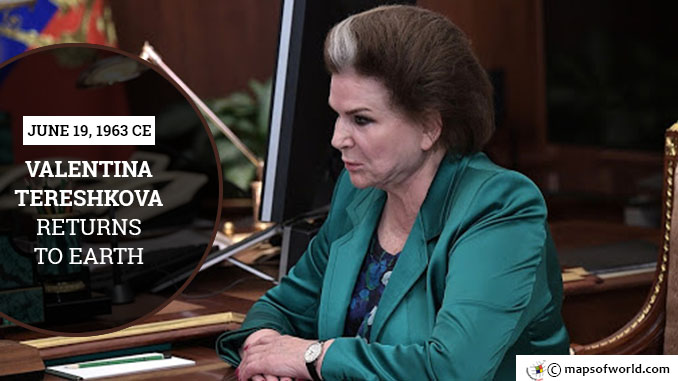After three days in space, the first woman to ever be launched into orbit returned to terra firma on this day in 1963. Valentina Tereshkova, a 26-year-old parachute enthusiast with just a year’s worth of flight training, would have to wait sixteen years to before she had company in one of history’s most exclusive clubs. Tereshkova’s rise to become one of the most prominent figures in Russia is nearly a fairy tale. Born on March 6, 1937 in the tiny town of Maslennikovo to a pair of Belarussian immigrants, her “proletariat background” played a role in her selection for inclusion in the female cosmonaut corps from a pool of more than 400 applicants. With a mother working in local textile factory and a father who had died as a tank sergeant in Finland during World War II (when Tereshkova was just two years old), she stood out even amongst the five women who were selected. In February of 1962, Tereshkova began training for a mission set to take place sometime between March and April of 1963. Though all the candidates were accomplished parachutists, they endured a further 120 drops, weightless flight training, G-force simulations, classes in rocketry and piloting lessons in top-of-the-line MiG-15s before final examinations in November 1962. Commissioned a Junior Lieutenant in the Soviet Air Force after passing the tests, the Soviet State Space Commission planned to launch Vostok 5 and Vostok 6 on consecutive days with women at the helm. Tereshkova would go first, followed by Valentina Ponomaryova. On May 21, 1963, Soviet Premier Nikita Khruschev approved of a new mission. Vostok 5 would launch on June 14th, flown by Valery Bykovsky with Tereshkova taking off two days later in a joint male-female flightplan. That Sunday morning, after a two-hour countdown, she started her journey into orbit. Over the course of 71 hours, she would circle the planet 48 times, coming within three miles of her compatriot Bykovsky at one point. When she returned home on the 19th, landing three hours before Bykovsky, Tereshkova had logged more hours in space than the entire roster of American astronauts up to that point. Greeted as a hero by both government officials and an adoring public, she received the Hero of the Soviet Union (the nation’s highest award) on June 22nd. Life after spaceflight would be eventful: she was married just five months later to Andrian Nikolaev, a fellow cosmonaut, and soon became active in the Communist Party. Over the next thirty-five years, Tereshkova – who went on to earn a doctorate in engineering – could arguably be called the most famous Russian woman in the world. Well-regarded as a politician and still the only woman to rise to the rank of general in the Soviet or Russian military, Tereshkova retired from the air force in 1997 and retreated from the spotlight. In April 2011, Russian President Dmitry Medvedev presented her with the Order of Friendship in recognition of her contribution to “strengthening the friendship and cooperation between peoples” at the age of 78.
June 19, 1963 CE – Valentina Tereshkova Returns to Earth
After three days in space, the first woman to ever be launched into orbit returned to terra firma on this day in 1963. Valentina Tereshkova, a 26-year-old parachute enthusiast with…
385
